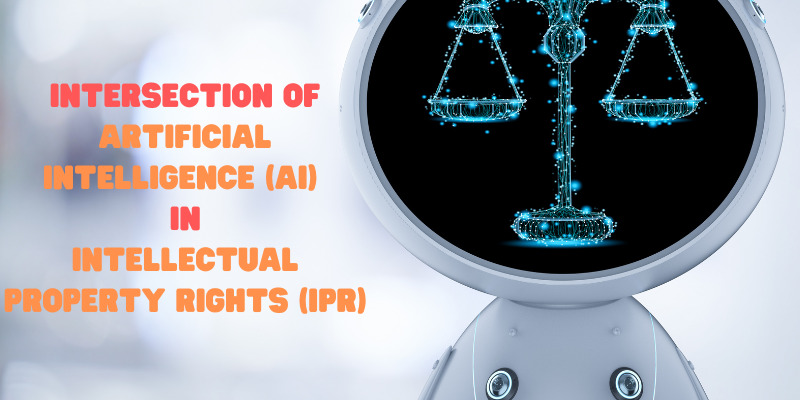View News
INNOVATION-UNVEILED-AI-ROLE-IN-INTELLECTUAL-PROPERTY-RIGHTS

INNOVATION UNVEILED: AI'S ROLE IN INTELLECTUAL PROPERTY RIGHTS
Artificial Intelligence (AI) stands out as a revolutionary force in the quickly changing technological landscape, transforming economies, society, and industries. Artificial Intelligence is becoming more and more integrated with one of the core components of innovation: intellectual property rights (IPR). This article will explores the opportunities, problems, and repercussions at this critical confluence as it digs into the intricate and dynamic interaction between AI and IPR.
The confluence of Artificial Intelligence (AI) and Intellectual Property Rights (IPR) is one of the most fascinating and intricate developments in the contemporary history of law and technology. In addition to serving as an essential tool for safeguarding and enhancing human creativity and discoveries, intellectual property rights also allow the authors to be fairly compensated for their contributions.
One of the newest fields of technology and law is artificial intelligence (AI). Here, discussions and conundrums surrounding copyrights, patents, and other intellectual property matters are still being worked out, with the main point of contention being the relative merits of human labour versus AI-generated resources.
Navigating Patent Landscape:
In a 2019 report on trends in patent applications and grants, the World Intellectual Property Organization (WIPO) noted that the disciplines of telecommunications, transportation, and life and medical sciences have recently seen an increase in AI-related applications. These patents cover technologies in the fields of computer vision, speech recognition, and natural language processing. In the United Kingdom, the United States, and Europe in 2017, patent applications were filed naming DABUS, an AI system, as the inventor.
However, because it did not meet the requirements of most Intellectual Property Rights (IPR) regimes—namely, being a legal person—the application was denied in all three nations. Similarly, the UK's Press Association and Urbs Media have established Reporters and Data and Robots (RADAR), an AI system that will assist in producing local news material based on templates made by actual journalists across a variety of genres, thanks to funding provided by Google's Digital News Initiative. Whether AI may be considered the author or creator of discoveries has become a topic of significant discussion in the field of intellectual property rights (IPRs) due to the recent spike in patent filings claiming authorship or ownership by AI.
A separate issue that is considered in the context of AI and IPRs is the practical difficulty of the patentability of AI systems in the context of the subject-matter eligibility standard. In most jurisdictions, algorithms by themselves qualify as a vague system lacking technical character, and hence cannot be protected under the IP laws, unless it has been given a technical character in the form of effective software. However, in response to the changes in technology and rising applications, IP regulators in different countries have also come up with guidelines regarding examination, and initiatives to encourage patent protection in these areas of technology. They provide clarity over the eligibility of algorithms that can come under the purview of patentability, for them to then be tested on merits such as novelty and enablement.
Navigating Copyright Landscape:
The ownership of creative works is governed by copyright law in many jurisdictions, which gives creators the exclusive right to their original expressions. Applying copyright law to content created by AI presents certain difficulties, though. Content created by autonomous AI systems might be difficult to integrate into traditional ideas of authorship, which assign creative works to human creators. Legislators and courts are debating issues including whether AI-generated content qualifies for copyright protection and, if so, who should be regarded as the legitimate owner.
Currently, AI-generated creative work is typically not protected by copyright; instead, only human originality within the piece is protected. This is so because artificial intelligence (AI) mimics what it learns from programming rather than creating original content. As a result of the significant similarities between what AI software learns and the creative work it produces, The intricate writing process can now be completed with only one click thanks to ChatGPT's entrance to the writing community. Considering that artificial intelligence (AI) software uses data from millions of sources to learn and produce new works. Artificial intelligence is capable of producing complicated tasks that may be beyond the capabilities of people in a short amount of time. The recently produced masterwork.
|
CRUCIAL FACTORS |
OWNERSHIP |
|
Employer-Employee Relationships: |
The "work made for hire" doctrine in copyright law stipulates that employers typically own the rights to works created by employees in the course of their employment. Thus, if an employee develops an AI system as part of their job duties, the employer may claim ownership of the AI-generated content. |
|
Contractual Agreements |
Clear contractual agreements between parties involved in AI development and deployment can play a crucial role in determining ownership rights. Developers, users, and other stakeholders can define ownership, licensing, and usage rights through carefully crafted contracts. These agreements may specify who owns the AI and its outputs, how the content can be used, and any revenue-sharing arrangements. |
|
Ethical Considerations |
Questions of fairness, accountability, and transparency arise, particularly concerning the attribution of creative works. Ensuring that creators receive proper credit for their contributions, whether human or AI-assisted, is essential for maintaining trust and integrity in creative processes. |
Navigating Trademark Landscape:
The effectiveness of the AI software on trade marks is in its ability to quickly and efficiently gather large amounts of data and analyze them, saving time, money, and labor from human labor. AI tools are able to leverage search engines and databases more effectively. It will be challenging for a person to carefully review each application and distinguish identical products, similar services, and marks that are confusingly similar from them due to the rise of both registered trademarks and trademark applications for registration. However, by comparing one mark with another, an AI program may fully utilize search engines to uncover confusing and misleading goods and services. To a certain extent, the AI program can even predict whether a trademark would be accepted by the registry for registration.
Regarding trademarks, customer perception is a major factor that determines how well products and services perform in the marketplace. Customer searches, suggestions, and recommendations can be assisted by the AI software. Customers will ultimately have the last say in whether or not to purchase the goods, but the AI can promote products by emphasizing their usefulness, quality, and efficiency. This will improve customer-product engagement.
Navigating Design Landscape:
Not only can AI create logos, but it can also create websites and applications. The advent of artificial intelligence in the field of design has ushered in a new era of mass communication as well as the use of a wide range of software and artistic mediums, in contrast to decades of conventional design methods. Anyone can use AI to produce a design that precisely illustrates what the designer wants to convey with their work. AI-generated creative platforms such as DALL E 2 and MIDJOURNEY exist. With basic inputs in natural language, these AI systems are able to produce lifelike visuals and designs. The AI shouldn't have trouble understanding the question, and the description provided can be in different styles. But the most insane feature of this AI software, like DALL E 2 is that it is free.
Conclusion:
Artificial Intelligence (AI) is revolutionizing the world of intellectual property (IP). AI can help businesses and inventors create, manage and exploit IP assets. It can also raise complex legal and ethical questions about ownership, patentability and copyright infringement, as well as data protection. On the other hand, AI can help automate and simplify IP asset management. It can also help search and analyze existing IP assets, develop new business models and enhance IP enforcement. It is important for policymakers and IP professionals to be up-to-date with AI so that IP law can evolve to meet the demands of this fast-evolving technological environment.
"Unlock the Potential of Legal Expertise with LegalMantra.net - Your Trusted Legal Consultancy Partner”
Article Compiled by:-
Prerna Yadav
(LegalMantra.net Team)
Disclaimer: Every effort has been made to avoid errors or omissions in this material in spite of this, errors may creep in. Any mistake, error or discrepancy noted may be brought to our notice which shall be taken care of in the next edition In no event the author shall be liable for any direct indirect, special or incidental damage resulting from or arising out of or in connection with the use of this information Many sources have been considered including Newspapers, Journals, Bare Acts, Case Materials , Charted Secretary, Research Papers etc.

